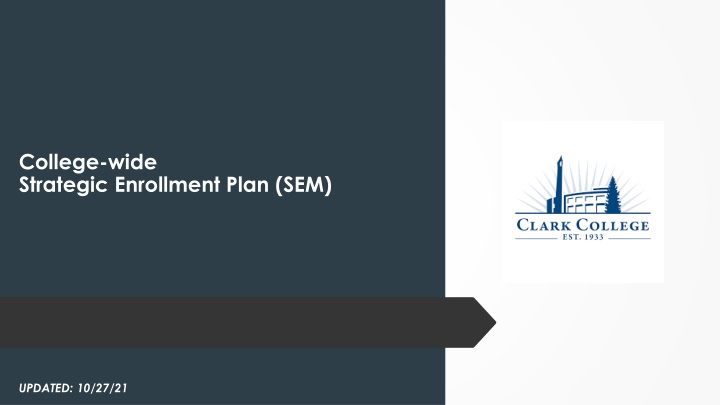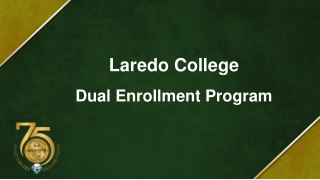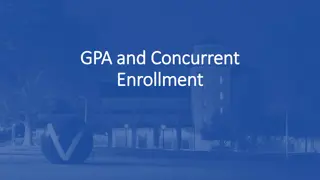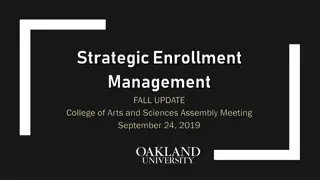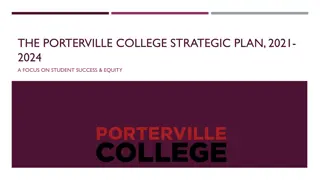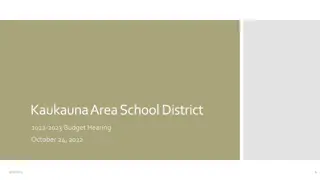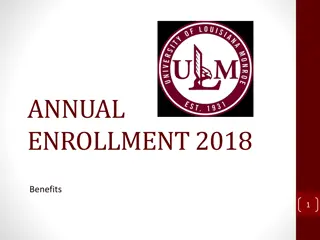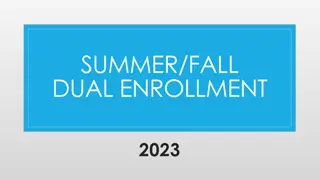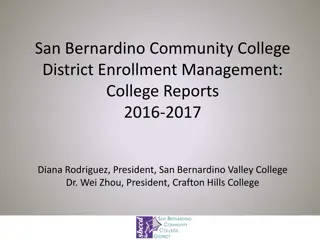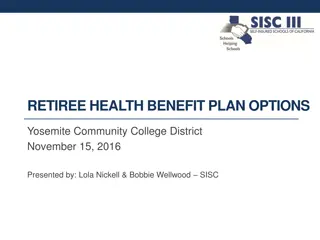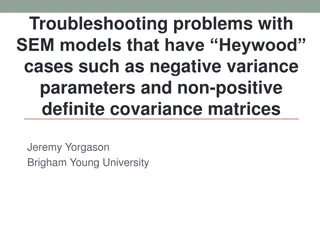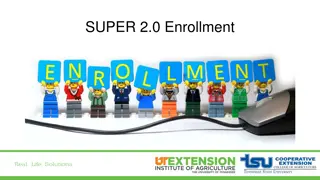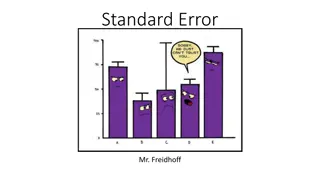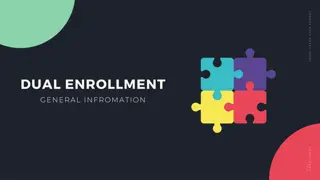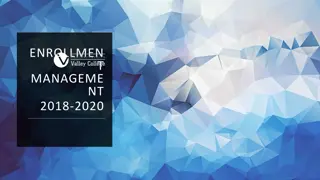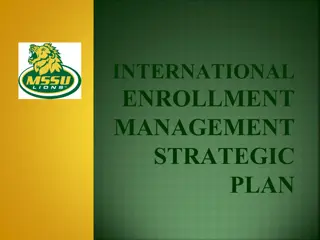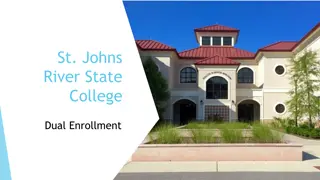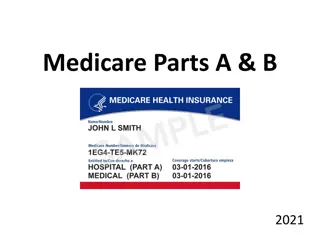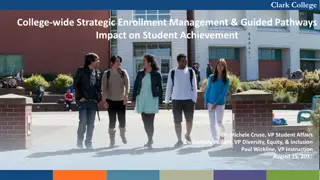College-wide Strategic Enrollment Plan (SEM)
This document outlines the College-wide Strategic Enrollment Plan (SEM) updated on 10/27/21. It provides a comprehensive overview of the strategic initiatives and goals aimed at enhancing and optimizing the enrollment processes across the institution. The plan addresses important aspects such as recruitment strategies, retention efforts, and overall enrollment management to ensure sustainable growth and success in meeting the institution's educational objectives.
Download Presentation

Please find below an Image/Link to download the presentation.
The content on the website is provided AS IS for your information and personal use only. It may not be sold, licensed, or shared on other websites without obtaining consent from the author.If you encounter any issues during the download, it is possible that the publisher has removed the file from their server.
You are allowed to download the files provided on this website for personal or commercial use, subject to the condition that they are used lawfully. All files are the property of their respective owners.
The content on the website is provided AS IS for your information and personal use only. It may not be sold, licensed, or shared on other websites without obtaining consent from the author.
E N D
Presentation Transcript
College-wide Strategic Enrollment Plan (SEM) UPDATED: 10/27/21
Overview: 3 -year plan; 5% enrollment increase What: A collaborative approach to identify, recruit, enroll, retain, close equity gaps, and graduate the student body. College-wide Strategic Enrollment Management Plan Overview Why: Increase Student Success Improve Campus Climate Obtain Financial Stability Expand & Deepen Community Engagement
Racial Equity Clark College leads with racial equity as a holistic approach to identify barriers and best practices relating to the retention, enrollment, and completion of historically underrepresented racial and ethnic groups. Using data to guide us, we proactively seek out best practices and eliminate barriers to ensure equitable outcomes for students and employees. We accomplish this through abolishing practices that do not effectively serve students or employees, dismantling White Supremacy Culture, and by adopting principles of anti-racism, disability justice, and universal design. Advancing Justice for the Clark College Community
Racial Equity Abolitionist Framework Collective Care Inclusive Practices Transformative Mindset Advancing Justice for the Clark College Community
College-wide SEM Stakeholders List Department Staff/Committees ODEI Retention SAC Business Office Instruction ASCC SA IC IPT EC Review SAC/IC BOT IT SEC COM/MAR Michele/Cindi/Rashida/Melissa Michele/Cath B./Heather A./Julie SAC review at Retreat Michele/Sabra Michele/Genevieve Student Government Review Review at SA All-staff meeting Review at Instructional Council Committee/Genevieve Executive Cabinet Meeting Town Hall Meeting & IC/SAC Meeting Board of Trustees Work Session Michele/Genevieve/Val Social Equity Committee Communications & Marketing Consultants
Achieve All Goals By 2024 Goal I: Increase prospect pool by 20%, increase conversion from prospect to applicant by 10%, increase applicant to enroll students by 5%, and experience flat enrollment. Goal II: Increase improve fall-to-fall retention of all students by 10%. College-wide Strategic Enrollment Management Plan Goals Goal III: Reduce the equity gap by 50% for non dominant historically underrepresented students in retention, progression, and completion. Goal IV: Increase student success outcomes by 5%. Goal V: Increase enrollment at CTC & CCW by 5% through Intentional Pathways and Holistic Support Services.
Goal I: By 2024, increase prospect pool by 20%, increase conversion from prospect to applicant by 10%, increase applicant to enroll students by 5%, and experience flat enrollment. Strategies Review, revise, and implement comprehensive prospective student recruitment and marketing systems. Create systems and models to support enrollment management. Create enrollment funnel to determine where students fall out of the funnel and implement intentional supports to pull students through. Increase outreach and recruitment efforts to Transitional Studies students. Develop and Implement placement prep Math boot camp that can be offered with a condensed COLL101 in Summer. Streamline Running Start Enrollment Process. Increase number of students who apply for Financial Aid.
Goal II: By 2024, increase fall-to-fall retention of all students by 10%. Strategies Through an equity-focused lens, reengage and revitalize college-wide guided pathways work by enhancing the student experience. Engage data coaches, use data-informed strategies, and data dashboards to guide programming and assessment. Increase the number of fully online degree pathways available to students and focus on high quality content and engagement Implement all-user adoption of an Early Alert System Create, within the framework of caseload advising, checkpoints for all students.
Goal II: By 2024, increase fall-to-fall retention of all students by 10%. Strategies (Cont.) Implement optimal annual course scheduling designed to allow student to efficiently complete degrees and certificates or transfer. Implement evidence-based placement practices. Implement College 101 or outcomes in every pathway. Expand use of Open Educational Resource (OER). Successful completion of English and Math in first year with supports. Reactivate identity-based student clubs.
Goal II: By 2024, increase fall-to-fall retention of all students by 10%. Strategies (Cont.) Implement Case Load Appreciative Advising. Implement Auto Enrollment for existing cohort programs. Identify pathways where COLL101 or embedded outcomes are not present.
Goal III: By 2024, reduce the equity gap by 50% for non-dominant historically underrepresented students in retention, progression, and completion. Strategies Implement culturally inclusive programming, engagement, services and activities (e.g., culturally responsive orientation; academic appreciative advising; holistic supports for systemically non dominant population, through equity competent Career exploration and/or College Success Courses). Develop co-requisite courses and other student supports to reduce equity gaps in gateway course success. Embed program-relevant Power, Privilege, and Inequity course work into all degree programs. Increase the number of systemically non-dominant students entering and completing high-demand, high wage programs.
Goal III: By 2024, reduce the equity gap by 50% for non-dominant historically underrepresented students in retention, progression, and completion. Strategies (Cont.) Enhance academic student supports to reduce equity gaps in course success. Accelerate rates of English completion within the first year. Accelerate rates of math completion within the first year. Leverage the efforts of TLC, ODEI, and SBCTC to provide equity focused professional development training for faculty & staff. Create MESA mentorship program to increase historically underrepresented student of color enrollment, retention, and completion in STEM-related programs. Continue to infuse culturally responsive curriculum throughout Clark programs.
Goal IV: By 2024, increase student success outcomes by 5%. Strategies Intentional Marketing and Outreach Plan Expand partnerships with industry, community organizations, and K-12. Assess the effectiveness of existing K-12 CTE articulations. Assess & resolve barriers in courses, processes, & placement, etc. Utilize the program viability process to ensure programs are tied to industry and community needs. Assessment of student support, ensure intentional student milestones (i.e.. Connection to Advisors and Faculty). Provide opportunities for career connection early in pathway. Develop part-time pathways for degree programs.
Goal V: By 2024, increase enrollment at CTC & CCW by 5% through Intentional Pathways and Holistic Support Services. Strategies Rebrand Columbia Tech Center. Provide Holistic Support Services at CTC and CCW. Create CCW as Home to Allied Health Pathways. Maximize course scheduling for Running Start participation at CTC/CCW, and plan for Boschma Farms campus. Generate student and community interest in Boschma Farms campus. Identify High-Demand BAS Programs to be located at CTC/CCW. Develop and expand partnerships with industry and labor partners around CCW (e.g., Legacy, PeaceHealth, SIEU, etc.). Includes pathways for incumbent workers; internships/externships; placement upon completion.
Goal V: By 2024, increase enrollment at CTC & CCW by 5% through Intentional Pathways and Holistic Support Services. Strategies (Cont.) Develop and expand partnerships with industry and labor partners around CCW (e.g., Legacy, PeaceHealth, SIEU, etc.). Includes pathways for incumbent workers; internships/externships; placement upon completion. Create course schedules that maximize simplicity for Running Start participation at CTC/CCW, including district-specific class offerings and alternate day/time/location to meet part-time needs.
Committee to finalize metrics for goals (budget, FTE projections, etc.) Committee to prioritize strategies/ Framework for 2021-2022 academic year Development of a College-wide Strategic Enrollment Management Data dashboard by Sep 15 Next Steps Establish tracking milestones ~ goals Identify leading vs. lagging indicators
College-wide Strategic Enrollment Management Committee Members Michele Cruse, Interim Vice President of Student Affairs Genevieve Howard, Interim Vice President of Instruction Rashida Willard, Vice President of Diversity, Equity, and Inclusion Mirranda Saari, Associate Dean of Enrollment Services and Registrar Vanessa Watkins, Director of Entry Services Cath Busha, Dean of Student Engagement John Maduta, Director of Advising Miles Jackson, Interim Associate Vice President of the Office of Instruction Armetta Burney, Interim Dean of Workforce, Professional & Technical Education Brenda Walstead, Dean of Business & Health Sciences Chippi Bello, Associate Dean of Financial Aid Julie Robertson, Director of Grant Development Kevin Damore, Director of Marketing Cindi Olson, Executive Assistant to the Interim Vice President of Student Affairs
